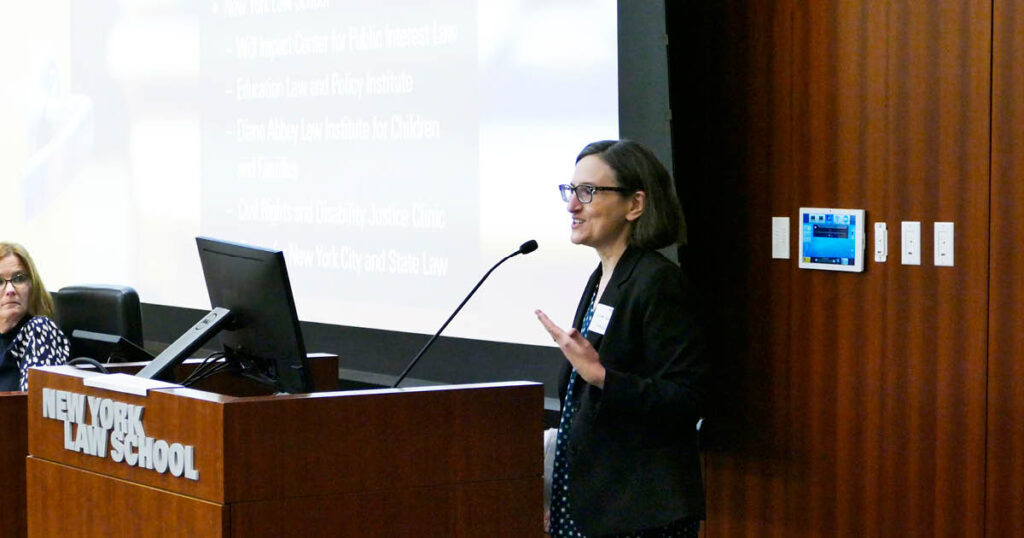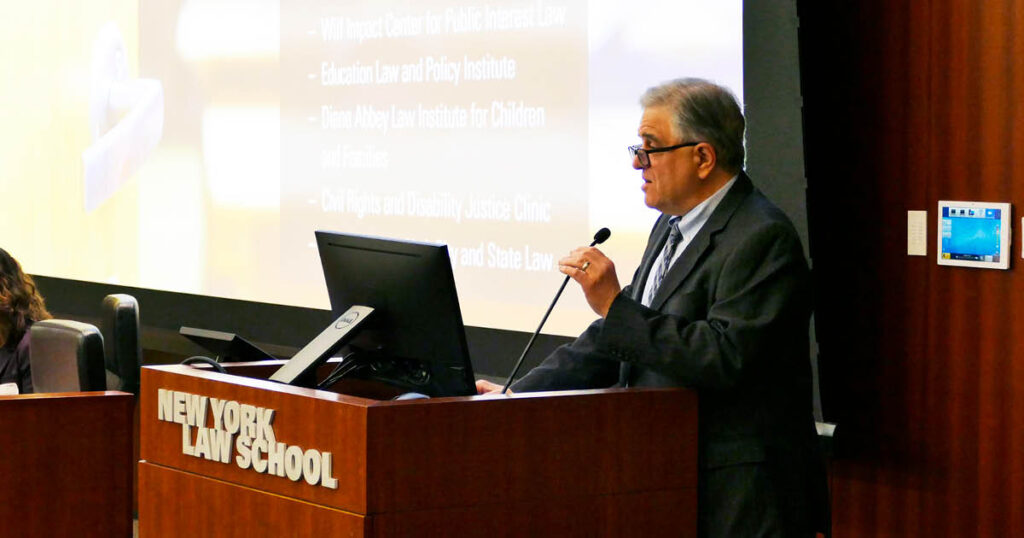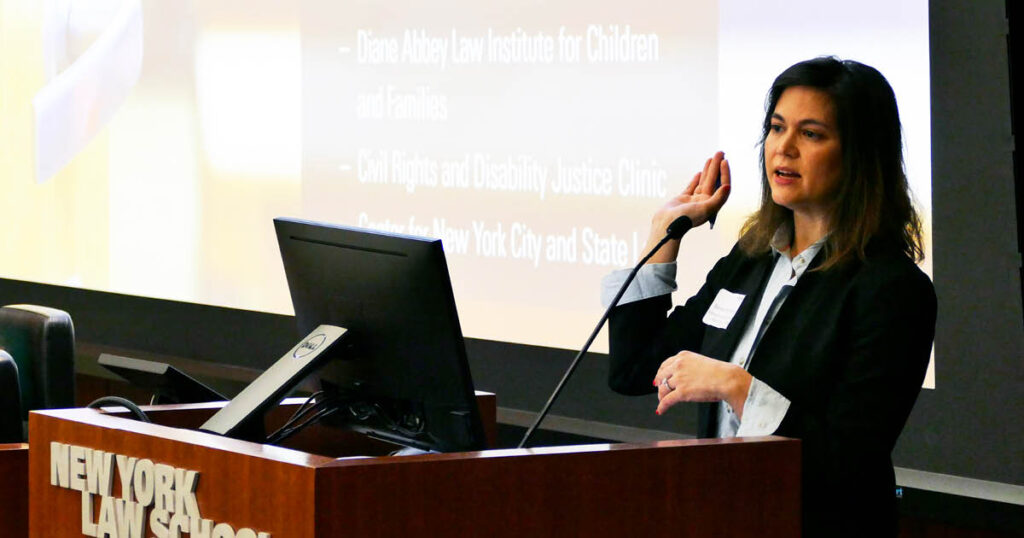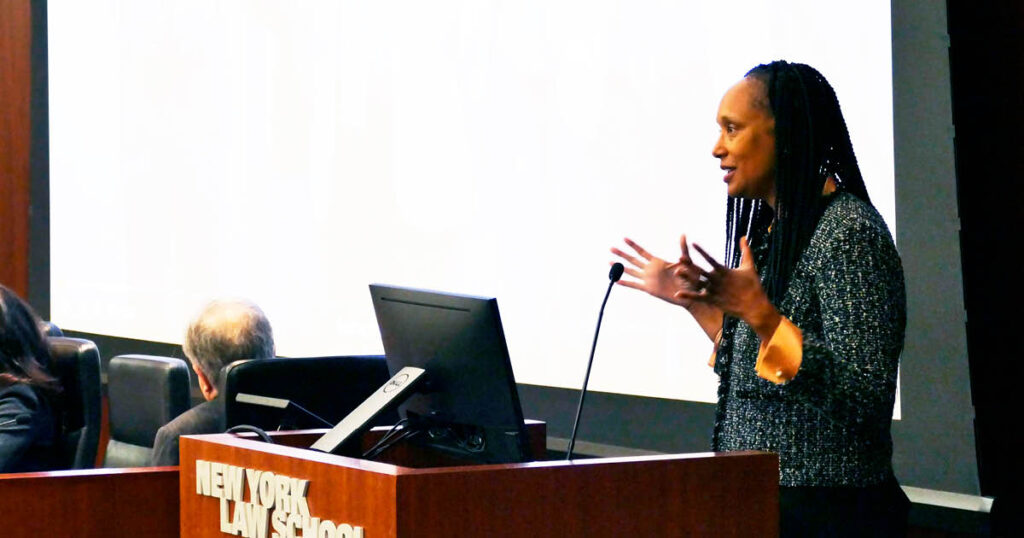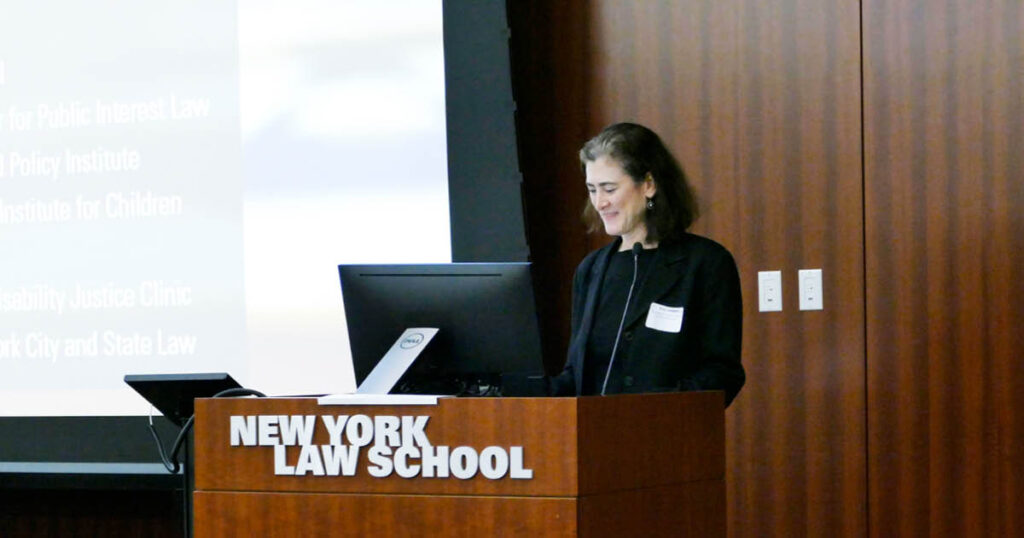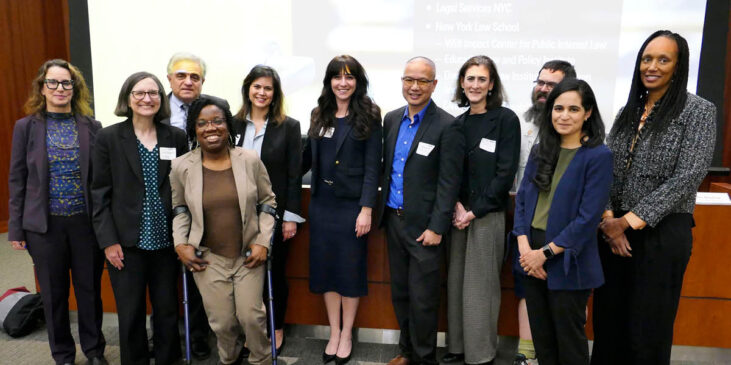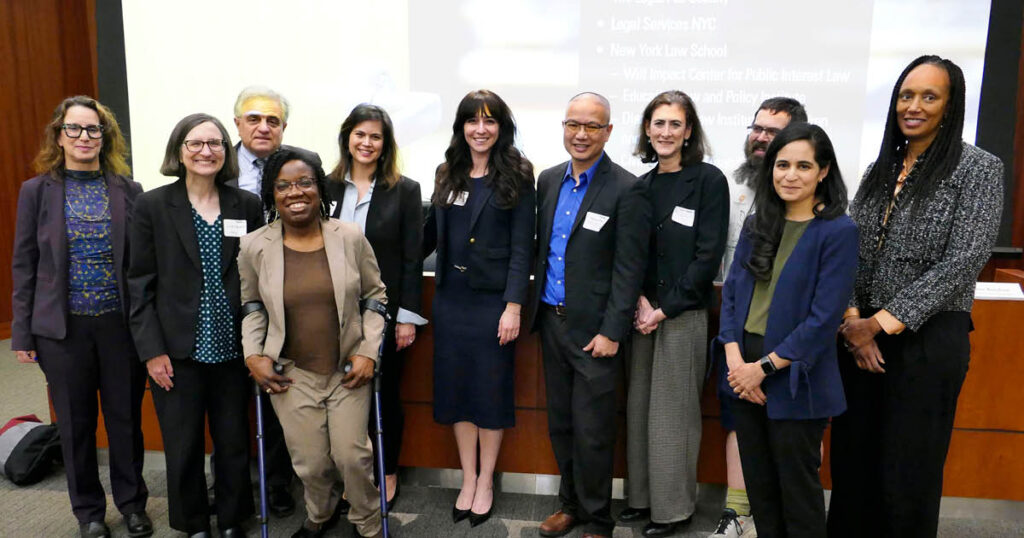
On March 28, 2025, the Wilf Impact Center for Public Interest Law at New York Law School convened a symposium, Progress Report: Education Justice 50 Years After Goss v. Lopez. Nationally renowned experts in constitutional law, family law, and education law, and community organizers, attorneys, and parents examined education access in light of the 50th anniversary of Goss v. Lopez, the U.S. Supreme Court’s 1975 decision regarding students’ disciplinary due process rights in education. While the event’s focus was on education law, it was also a meaningful opportunity for attendees to strategize on how to protect and improve education equity in light of current events.
Examining the History and Intersectionality of Disability and Racial Justice to Uphold Students’ Civil Rights
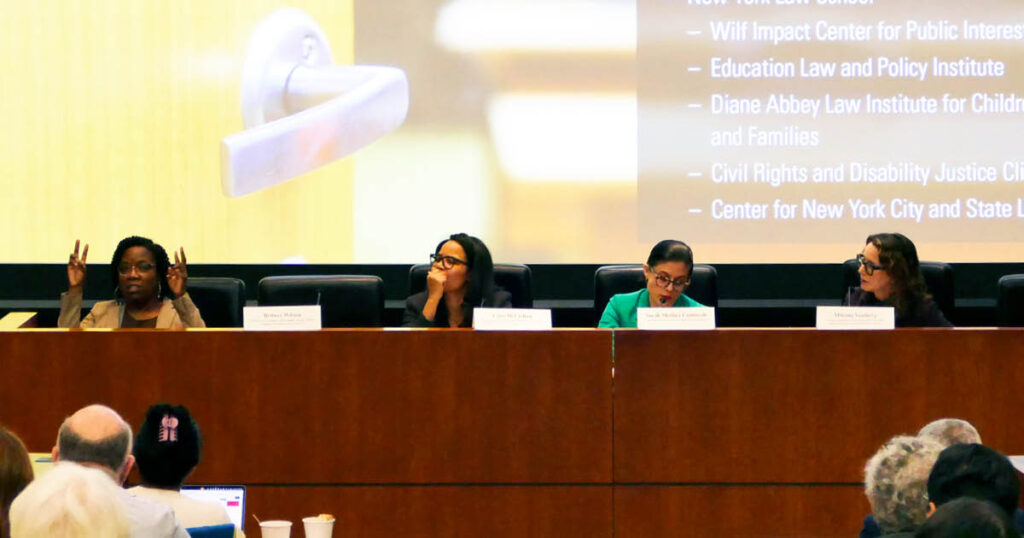
PANELISTS
- Sarah Medina Camiscoli, Assistant Professor of Law, Rutgers Law School
- Cara McClellan, Director of Advocacy for Racial and Civil Justice Clinic, Practice Associate Professor of Law, University of Pennsylvania Penn Carey Law School
- Miriam Nunberg, Senior Consultant of the Education Law and Policy Institute, and Adjunct Professor, New York Law School
- Britney Wilson, Director of the Civil Rights and Disability Justice Clinic, and Associate Professor of Law, New York Law School
The first panel discussed Brown v. Board of Education and its companion cases, whose plaintiffs faced exclusion from school because of their race and disability status. The discussion examined how some civil rights activists’ responses to the campaign to end segregation had the unintended consequence of disproportionately harming students of color and students of color with disabilities. The discussion then explored how districts circumvented post-Brown desegregation orders in the 1960s and 1970s by suspending Black students from school, including those who protested racial violence against Black people and persistent inequality in schools. This history upended the more commonly held assumption that school pushout did not begin until the era of Broken Windows Policing in the 1980s and 1990s.
This was the context for the student suspensions in Goss v. Lopez by different schools in Columbus, Ohio. Groups of students protested both the shooting of two Black students by a white student, and the continuing hostility and lack of support and instruction for Black and Latino students in desegregated schools. The schools summarily suspended the student demonstrators, without notice or an opportunity to be heard, including the named plaintiff, Dwight Lopez, who stated he was a bystander.
For the first time, the Supreme Court found these types of automatic removals from school unconstitutional under the Due Process Clause of the 14th Amendment. The court established an important floor for protecting students’ educational rights: A school district must provide a student with some kind of notice of the suspension, and an opportunity to respond to the allegations, before the student can be excluded from school. Panelists pointed out that Goss was a helpful step forward in safeguarding students’ ability to attend school when facing discipline, but they also found it problematic that the Supreme Court omitted the underlying facts from its opinion. These students’ disruption to classes was not only legitimate but necessary in a society that failed to acknowledge their experiences. In addition, the Supreme Court ignored the disparate impact of suspension policies on Black students, including then-current data from the National Association for the Advancement of Colored People’s (NAACP) amicus brief showing that Black students in Ohio public schools were more than twice as likely to be suspended than white students.
Finally, the conversation turned to how this history echoes in today’s youth-led movements for students’ access to an equitable education, with an exploration of how New York City high school students, teachers, parents, lawyers, and other allies, collaborated to file a ground-breaking lawsuit in 2021, IntegrateNYC v. State of New York, alleging state constitutional violations of the right to a sound, basic education, based, among other claims, on: tangibly unequal instructional resources for Black students and white students; stratifying students with entrance exams to gifted and talented and other “specialized” programs; and failing to teach a comprehensive, historically accurate, and culturally-responsive curriculum, all of which have had the effect of segregating students by race in New York City. As pointed out by the panelists, student and parent activists from Brown to IntegrateNYC did not seek “belonging,” rather, the objective has always been to participate fully in a society that upholds their “dignity and right to self-determination.”
Protecting Students’ Rights 50 Years after Goss v. Lopez
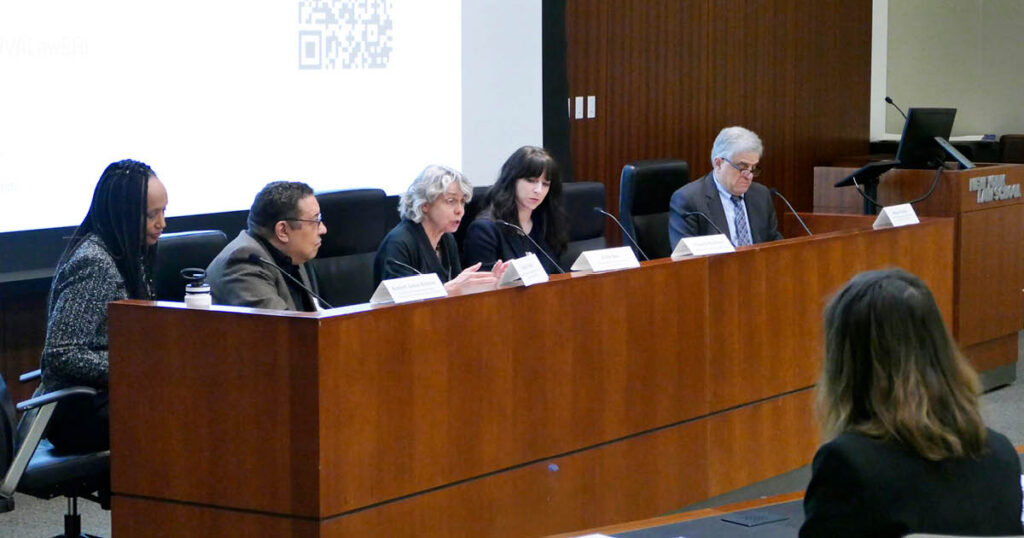
PANELISTS
- Emily Buss, Mark and Barbara Fried Professor of Law, University of Chicago
- Richard Marsico, Director of the Wilf Impact Center for Public Interest Law, Professor of Law, New York Law School
- Dennis Parker, Executive Director, National Center for Law and Economic Justice
- Kimberly Robinson, Executive Director, Education Rights Institute, Professor of Law, University of Virginia School of Law
- Michaela Shuchman, Skadden Fellow, Bronx Legal Services
The second panel addressed children’s rights in education broadly, with a preview of excerpts from the inaugural Restatement of Children and the Law, published by the American Law Institute. It looked at how the intersecting systems of criminal justice, special education, family law, and school discipline impact a child’s life outcomes. Panelists shared dynamic accounts of what due process looks like when a student is suspended for a long term (which is over five school days in New York) and the unintended consequences of putting a child through a formal hearing, similar to a trial, to decide whether the child should be excluded from school. It raised important considerations of what Goss did and did not accomplish in protecting children’s evolving property interest in education, which could now arguably include school-based meals and health care, for example; and the liberty interest students have in their reputations, which can impact their ability to stay in school, attain a post-secondary degree, and secure employment.
Finally, the panelists considered the importance of data collection to assess disciplinary outcomes, in particular the disproportionality of student suspensions by race and disability. Under Title VI of the Civil Rights Act, the United States Department of Education (USDOE) Office for Civil Rights (OCR), would traditionally monitor this information. However, with the new federal administration’s interpretation of Title VI as a vehicle to prohibit diversity, equity, and inclusion policies in institutions that receive federal funding, it seems unlikely that OCR will track this information to ensure discipline policies do not have a disparate impact on students in protected categories. Under this novel approach, teachers and administrators face additional challenges in creating safe and welcoming environments for all students. Finally, the panelists highlighted resources from the Education Rights Institute that clarify the difference between Title VI as it exists on the books, and how the government is now applying it to public schools.
During lunch, Derek Black, Constitutional Law Professor at the University of South Carolina provided remarks via video, including a less common consideration of exclusionary discipline: the impact on the schoolwide community and the substantive due process rights of students who are not suspended. Then, Kim Sweet, the outgoing Executive Director of Advocates for Children of New York, documented the powerful impact of former New York Chief Judge Judith Kaye’s School-Justice Partnership Taskforce, which brought together New York City students, parents, educators, and law enforcement personnel to design a long-term plan to end the school-to-prison pipeline in New York.
Closing the Gaps Left by Goss: Efforts to Improve Students’ Disciplinary Rights in New York
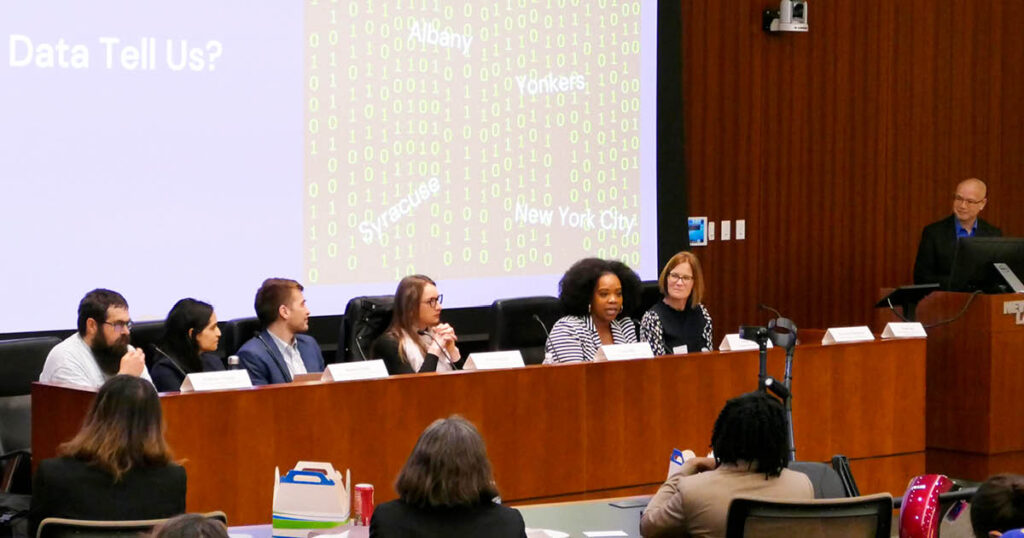
PANELISTS
- Christine Bingham, Staff Attorney, Legal Aid Society
- Angel Gray, Parent Representative, Solutions Not Suspensions Coalition
- Carly Hite, Senior Staff Attorney, Children’s Rights
- Nelson Mar, Senior Staff Attorney, Bronx Legal Services, and Adjunct Professor, New York Law School
- Kyle Rapiñan, Assistant Attorney General, New York Attorney General’s Office
- Rohini Singh, Director, School Justice Project, Advocates for Children
- Chauncy Young, Director, New Settlement Parent Action Committee
The final panel of the symposium provided an in-depth review of statewide organizing and advocacy efforts in New York to remove harmful exclusionary responses to students’ behavior and reconceptualize discipline in schools.
The presentation began with an overview of suspension laws in New York State, which are codified in N.Y. Education Law § 2801 and § 3214, and expand upon the due process protections established by Goss, such as the right to a hearing for a long-term suspension which begins after five school days (instead of Goss’s 10). The speakers also shared recent suspension data from the state. In the 2023–24 school year, there were: 8,334 pre-kindergarten through grade three students suspended; students with disabilities comprised 17 percent of the student population but received 31 percent of total days of exclusion, totaling 296,339 days; and Black students comprised 16 percent of New York’s student population but experienced 32 percent of days of suspension equivalent to 303,078 days. In the same school year in New York City, students with disabilities were 22 percent of the population but accounted for 43 percent of long-term suspensions; and Black students made up less than 20 percent of overall enrollment but received 45 percent of long-term suspensions.
Normally, this type of disparate impact on Black students and students with disabilities could trigger OCR review of disciplinary practices. However, as noted by Assistant Attorney General Rapiñan, now that advocates can no longer rely upon OCR to uphold Title VI, they are increasingly turning to local and state tools, such as New York City and State Human Rights laws, to track policies’ impact on students’ civil and human rights.
Panelists then detailed an example of one of these tools in New York City, a 2010 law called the Student Safety Act (SSA), which requires schools to track student disciplinary and arrest data disaggregated by race and other demographic data. For the past 15 years, these data have captured the systemic impact of suspensions, showing for example, that non-violent offenses like “insubordination” accounted for a majority of suspensions, and that Black students tended to be suspended more often than any other group. This data provided advocates with evidence to support removing “insubordination” and other subjective infractions from the New York City Discipline Code in 2014, and reducing possible suspension lengths in 2019.
This panel also included many representatives from a coalition of advocates to amend New York law with an additional tool, the Judge Judith S. Kaye Solutions Not Suspensions (SNS) Act, named in honor of the aforementioned trailblazing New York Court of Appeals Chief Judge Kaye. The law would make suspensions a last resort and “require schools’ codes of conduct to include restorative approaches to discipline to proactively foster a school community based on cooperation, communication, trust, and respect.” These provisions would also help close access to justice gaps across the state, where some school districts have failed to uphold even the most minimal due process protections under Goss. State Senator Robert Jackson is the sponsor of the SNS bill. The bill would shorten the current maximum suspension length of 180 days; provide a minimum number of hours of adequate academic instruction (e.g., more than two hours for high school students in New York City) and the opportunity for suspended students to take exams and earn credit; and explicitly require charter schools to follow state education laws on student behavior and discipline. The coalition has already made an impact, with the Legislature amending Education Law § 2801 to require districts with law enforcement or school safety personnel to adopt a written Memorandum of Understanding that clearly defines the role of these personnel, and prohibits their involvement in disciplinary matters.
To conclude the day, each panelist facilitated breakout sessions with the audience to identify “changes that could be made right now” to improve disciplinary outcomes and what individuals can do to help keep students in school. Groups reported back that improving access to mental health services and implementing evidence-based and restorative discipline practices–including training educators in trauma-informed approaches to teaching and learning–would allow more students to thrive in their school communities. Finally, participants returned to one of the very powerful themes to emerge from the day: that the first step any one of us can take in our daily lives is to fight the erasure of these histories by elevating the voices of Black students with disabilities who helped end segregation, the parent and student activists from Goss who were blotted out of the Court’s opinion, the young people and their allies who protested and continue to protest systemic inequities, and the work of communities, attorneys, and local and state officials, who have worked to support students and their families in this prolonged arc towards education justice.
